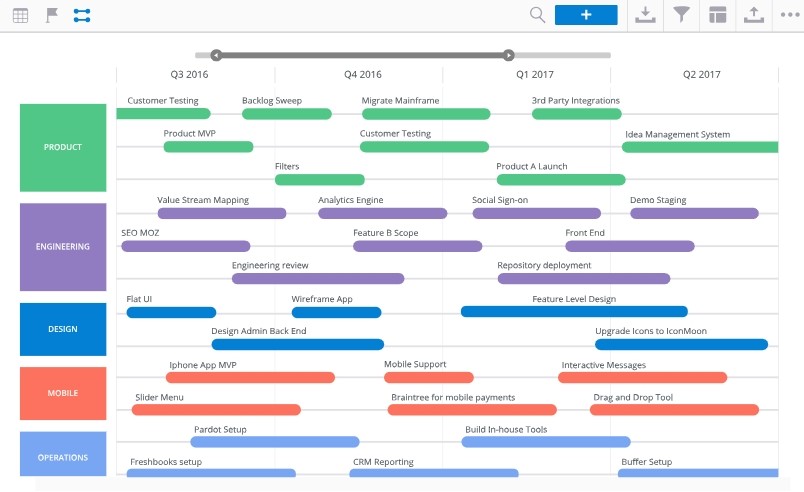11 backlog optimization tips
The management of the product backlog can raise questions even among the most experienced product managers and owners. When backlog is growing like a snowball, urgent measures have to be taken. The main ones are in this article.

How to manage backlog effectively? 11 practical tips will help answer this question for those who seek to bring order to the backlog and “bring” it to an ideal state.
Before you start managing the backlog of the product, that is, the queue of accumulated tasks ( product backlog ), evaluate the strategy of your product: is everything okay with it? A well-described strategy is a way to realize your product vision. This beginning began, without which the future life of the product is not possible. The stage of preparation of the strategy takes place with simultaneous research and analysis of the market.
')
Concentrate your backlog on the upcoming release, as this is a strategic component, which describes all the details of the product and the history of users that should be implemented. Long-term product development plans are best described in a product roadmap .
Sometimes product owners and managers can allow 50, 100, 200 and even more accumulated questions and tasks. Such a backlog looks uncontrollable and, at times, hopeless. In this case, they are quite difficult to manage and create transparency. It is logical that it is not so easy to say where the product moves under such circumstances.
As a product manager, project manager, or product owner, you must decide how to maximize results, minimizing costs and effort.
Managing your backlog with a convenient roadmap helps you “jot down” and plan how to use and implement your product and its life cycle. Often this document is the basis of successful backlog management.
Product roadmap will help visualize upcoming releases with their goals and milestones. Here is how the road map helps to implement the Roadmunk service:

Collaboration of the product manager with the development team is an important aspect of backlog management. An active collaboration on all issues of accumulated tasks will provide a quick and effective result. Involve your team members to discuss product issues. This will help to identify technical risks, increase understanding and awareness of the product and receive clearer and clearer requests from customers.
No need to hide the current backlog status. Make it transparent to stakeholders so that everyone can check the latest product status and provide useful feedback. This will help in making difficult decisions.
The backlog of your product will be healthy if you regularly take care of it with the development team. To do this, there is a special process or team event known as product backlog grooming or refinement.
Backing up or grooming is crucial for product management, because this process increases the chances of creating the product that users really want.
Analyze feedback and comments and apply new ideas for backlog tasks. Remove unnecessary and add the most relevant ones, break large tasks into smaller ones, in general, keep backlog tasks in a clean and healthy state.
User stories are also very important, but they are usually not enough to fully understand how the relationship with the product goes. Use direct user interaction and record the results in the backlog.
Check and make changes. If you are working on Agile, the changes are likely to be enough. Update your roadmap between three weeks and three months. It usually depends on how “young” your product is and how dynamic the market is.
Prioritization is a key point in backlog work. It is not always easy to determine how soon a specific task should be implemented. A timely decision on a specific issue allows you to avoid mistakes, to understand how to proceed and not allow backlog to grow.
Many product managers use convenient Value and Efforts for each idea to prioritize.
Comparison of these combinations helps to better determine the significance and “weight” of tasks and select the most important ones for the next job.

To visualize backlog tasks and prioritize them, you can use a plain sheet of paper, a board, or simple Excel tables. However, for the convenience and efficiency of product managers, special tools and services have been developed.
An example of such a tool is Hylog.io's Backlog Priority Chart.
And how do you manage the product task queue? Which of the following steps to optimize the product backlog seemed to you the most useful?

How to manage backlog effectively? 11 practical tips will help answer this question for those who seek to bring order to the backlog and “bring” it to an ideal state.
1. Start with the preparatory work.
Before you start managing the backlog of the product, that is, the queue of accumulated tasks ( product backlog ), evaluate the strategy of your product: is everything okay with it? A well-described strategy is a way to realize your product vision. This beginning began, without which the future life of the product is not possible. The stage of preparation of the strategy takes place with simultaneous research and analysis of the market.
')
2. Focus on the essentials.
Concentrate your backlog on the upcoming release, as this is a strategic component, which describes all the details of the product and the history of users that should be implemented. Long-term product development plans are best described in a product roadmap .
3. “Keep” the backlog in a manageable state.
Sometimes product owners and managers can allow 50, 100, 200 and even more accumulated questions and tasks. Such a backlog looks uncontrollable and, at times, hopeless. In this case, they are quite difficult to manage and create transparency. It is logical that it is not so easy to say where the product moves under such circumstances.
As a product manager, project manager, or product owner, you must decide how to maximize results, minimizing costs and effort.
4. Use the roadmap
Managing your backlog with a convenient roadmap helps you “jot down” and plan how to use and implement your product and its life cycle. Often this document is the basis of successful backlog management.
Product roadmap will help visualize upcoming releases with their goals and milestones. Here is how the road map helps to implement the Roadmunk service:

5. Communicate and collaborate
Collaboration of the product manager with the development team is an important aspect of backlog management. An active collaboration on all issues of accumulated tasks will provide a quick and effective result. Involve your team members to discuss product issues. This will help to identify technical risks, increase understanding and awareness of the product and receive clearer and clearer requests from customers.
6. Share your backlog with interested parties.
No need to hide the current backlog status. Make it transparent to stakeholders so that everyone can check the latest product status and provide useful feedback. This will help in making difficult decisions.
7. Hold Backlog Optimization Meetings
The backlog of your product will be healthy if you regularly take care of it with the development team. To do this, there is a special process or team event known as product backlog grooming or refinement.
Backing up or grooming is crucial for product management, because this process increases the chances of creating the product that users really want.
Analyze feedback and comments and apply new ideas for backlog tasks. Remove unnecessary and add the most relevant ones, break large tasks into smaller ones, in general, keep backlog tasks in a clean and healthy state.
8. Work with user stories
User stories are also very important, but they are usually not enough to fully understand how the relationship with the product goes. Use direct user interaction and record the results in the backlog.
9. Update the roadmap regularly.
Check and make changes. If you are working on Agile, the changes are likely to be enough. Update your roadmap between three weeks and three months. It usually depends on how “young” your product is and how dynamic the market is.
10. Assign Priorities
Prioritization is a key point in backlog work. It is not always easy to determine how soon a specific task should be implemented. A timely decision on a specific issue allows you to avoid mistakes, to understand how to proceed and not allow backlog to grow.
Many product managers use convenient Value and Efforts for each idea to prioritize.
Comparison of these combinations helps to better determine the significance and “weight” of tasks and select the most important ones for the next job.
- The Value parameter indicates what business value your product or business can bring.
- The Efforts parameter measures the resources needed to complete a task.

11. Visualize
To visualize backlog tasks and prioritize them, you can use a plain sheet of paper, a board, or simple Excel tables. However, for the convenience and efficiency of product managers, special tools and services have been developed.
An example of such a tool is Hylog.io's Backlog Priority Chart.
And how do you manage the product task queue? Which of the following steps to optimize the product backlog seemed to you the most useful?
Source: https://habr.com/ru/post/358080/
All Articles